Denne Genealogy
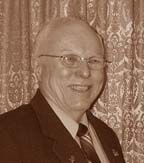 This page was set up by Robert Sewell in June 2006 to show the Denne Family
since the earliest known times. Robert Sewell graduated from McMaster
University (Hamilton, Ontario, Canada) in 1967 with a B.Sc. degree in chemistry.
After a year of studies at the University of Toronto's College of Education,
he taught high school science in Collingwood, Ontario for a year and then
taught chemistry, physics and general science in Hamilton, Ontario for
twenty-nine years. Robert Sewell retired from teaching in June 1998.
This page was set up by Robert Sewell in June 2006 to show the Denne Family
since the earliest known times. Robert Sewell graduated from McMaster
University (Hamilton, Ontario, Canada) in 1967 with a B.Sc. degree in chemistry.
After a year of studies at the University of Toronto's College of Education,
he taught high school science in Collingwood, Ontario for a year and then
taught chemistry, physics and general science in Hamilton, Ontario for
twenty-nine years. Robert Sewell retired from teaching in June 1998.
Click
to contact Robert Sewell
Sources of Information
The information on this page is primarily a result of
exhaustive investigations
by my cousin Sewell V. Sample, who listed his sources
as follows:
| "I found in Fort Wayne what I could, but I suspect there is lots more
if one hunts. My sources included:
"Burke’s History of Commoners, Vol. III, 1838, pages 19-21
(Click on Denne
of Kent and Sussex for an online version.)
"A publication of the Harleian Society (call number gc 929.72062 K41b)
page 99
(this is likely the Visitation of Kent, 1619 click on
Visitation
of Kent for an online version.)
"Pedigrees of the Families in the County of Kent, William
Berry gc 942.2301 B45c, pages 113, 194-5, 268-70, 352
(Click on Pedigrees
of the Families in the County of Kent for an online version of
pages 194 & 195)
"Unidentified book (I think entitled County of Kent),
pages uncertain, but look in index under Robert de Gatton and Denne Hill."
"Sewell V. Sample"
|
Additional Information comes from:
-
Norm Medland who shared the biographical
account of {Major General} Daniel Gookin and others.
-
Richard N. Gookins, An Historical and Genealogical
Sketch of The Gookin Family of England, Ireland and America, Tacoma,
Washington, 1952. (Available from Higginson
Books of Salem, Ma.)
-
The Gookin pedigree chart from E. E. Salisbury's Family
Memorials, Privately Printed, 1885.
-
E. E. Salisbury, Family Memorials, Privately
Printed, 1885, pages
381 - 383
-
Gregory Holyoake whose photographs of the Romney Marsh churches
appeared in Secret England.
-
Janet Denne of Australia who has kindly shared information
from an unpublished manuscript on the history of the Denne Family written
by Frederick Slater and dated 1880. The four Denne Coats of Arms
come from this manuscript.
Please visit the Sewell
Genealogy Site Map for other pages in this series.
England in the 11th Century
Edward the Confessor was born in 1002,
son of King Æthelred the Unrede and Emma of Normandy, who was a sister
of Richard (II) "the Good", 4th Duke of Normandy. Following the invasion
of England and the victory in 1013 of the Danish King Sweyn Forkbeard,
it was natural that King Æthelred, his wife Emma and their family
sought refuge in the court of Emma's brother, Richard "the Good". They
certainly took retainers with them, and it is possible that a member of
the Dene family was included.
However, Sweyn Forkbeard was never
actually crowned King of England; and when he died on February 3, 1014,
the Witan recalled Æthelred who reigned until his death on April
23, 1016. Emma, too, returned to England. Following the death of
Æthelred, she married the Danish King Canute; who, incidently, proved
to be a fair and honest king who provided a reign of peace with honour
for Anglo Saxons and Scandanavians alike. The young Edward the Confessor,
however, remained in Normandy until he was invited to return to England
in 1041 by his half brother and Canute's successor, the childless King
Hardecanute. Thus, St. Edward the Confessor had spent much of his
childhood and received his education in Normandy. When he was invited
to return to England in 1041, he was in many respects a Norman, and he
preferred to speak Norman French. Edward the Confessor was proclaimed King
of England following Hardecanute's death in 1042.
Saxon England was not a feudal state. The
King was served by a national militia plus his own retainers. The
earls were as powerful as the king himself, and were rivals as often as
allies. In order to strengthen his hold on the crown and to prevent the
Saxon earls from becoming too influential, King Edward the Confessor gave
fiefs to Norman lords. One of these Norman lords was Robert de Dene;
and although it cannot be proven, it is possible that he was a descendant,
perhaps a son, of a Saxon retainer who had accompanied the family of King
Æthelred of England and his queen, Emma of Normandy, into exile almost
thirty years before.
Origins of the Denne Family
In Saxon Britain, "dennes" were
rough clearings which threaded through the woodlands of the Kentish Weald
and gave free passage to livestock between areas of pasturage. The
dennes also provided a sort of woodland pasture, especially for swine.
Thus, the Denne name may be of Saxon origin; i.e., one who lived near or
made use of a denne.
It has also been suggested that the
name may come from the Norman French "Dene" meaning "the Dane"; thereby
suggesting a Scandinavian or Viking origin for the Denne Family. Click
here
to read an account found on a Denne Family Tree dated 1832 that suggests
the first of the Denne Family came to Normandy circa 911 with Rolf the
Ganger who became Robert,
1st Duke of Normandy.
Regardless of his exact ancestry, it
is with Robert de Dene that this genealogy begins.
Generation One
Robert de Dene a Norman,
had large estates in Sussex and Kent as well as in The Duchy of Normandy.
He was “pincerna”, a household official in charge of wines and beverages,
to King Edward the Confessor (1042 – 1066).
Robert de Dene had a son:
The Arms of de Dene
or Denne circa 1050.
The shield and Coat of Arms was
authenticated at
the Heralds College from the original manuscript by the
personal inspection of, and copied by, Frederick Slater on December 8th
1880.
|
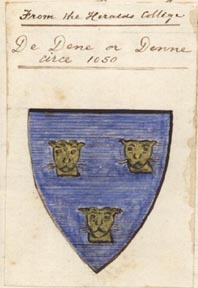 |
Generation Two
Robert de Dene
Robert de Dene had a son and heir:
Generation Three
Ralph de Dene, Lord of Buckhurst
in Sussex, possessed large estates in Sussex and Kent.
Living: during the reign of William the Conqueror (1066
– 1087)
Married: Sybella de Gatton, sister of Robert
de Gatton.
Ralph de Dene and Sybella de Gatton had the following
children:
-
Ella de Dene who married Sir Jordan Sackville, ancestor
of the Dukes of Dorset. Ella inherited Buckhurst and other estates in Surrey.
In her widowhood, she endowed Bayham Abbey.
Generation Four
Robert de Dene
Born circa 1130
Robert inherited the Kentish Estates. He married
Sybylla and they had the following children:
-
William de Denn
-
Alice de Denn who endowed Bayham Abbey.
-
Agnes who married De Icklisham.
Generation Five
William de Denn of Denn Hill,
in the Parish of Kingston on Barham Downs, Kent, had a son:
Generation Six
Sir Alured de Denn of Denn
Hill.
Living "19 Henry III", i.e., 1234
Sir Alured de Denn was known as a person of great learning.
He was Seneschal (the official who governed the overall operation of the
household) of the Priory Christ Church of Canterbury and Escheater of Kent
in 1234. He was appointed by King Henry III (1216 – 1272), in conjunction
with Sir Henry de Bath, to enforce the the Laws of Romney Marsh, on or
near the channel coast of Kent between Folkstone and Dungeness.
Sir Alured de Denn had three leopard heads caboshed (i.e., three leopard
"faces") on his seal.
Sir Alured de Denn had the following sons:
-
Walter Denne
-
George Denne
-
John Denne
Romney Marsh extends for sone 25 miles
along the coast from Hythe to Rye and runs 10 miles inland to Appledore,
linking the two counties of Sussex and Kent. It is a flat, remote,
hazy expanse, reclaimed from the sea and intersected by a tangled network
of roads and waterways that connect the myriads of small towns, villages
and isolated hamlets.
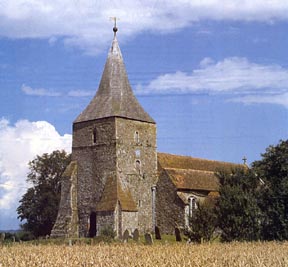
|
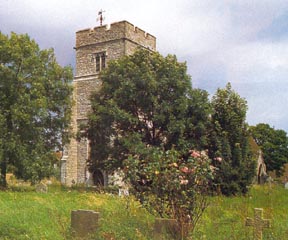
|
Saint Mary-in-the-Marsh
This 12th century church is visible for miles.
|
Saint Peter and Saint Paul
The tower of this Norman church leans to the west.
|
Generation Seven
Walter Denne of Denne Hill,
living in 1256, had a son:
Generation Eight
Walter Denne of Denne Hill,
living in the 9th Edward I (1281) had a son:
Generation Nine
John Denne of Denne Hill,
living in 1308, had a son:
-
Sir William (or Walter) Denne
Generation Ten
Sir William (or Walter) Denne
Knight of Denne Hill, sat in Parliament for the City of Canterbury in 19
Edward II (1326) and for the County of Kent in 14 Edward III (1341).
Sir William married to Elizabeth de Gatton, daughter
and co-heiress of Hamo de Gatton of Boughton, and they had a son:
Generation Eleven
Richard Denne of Denne Hill
was living in 6 Richard II (1383).
Richard married to Agnes Apuldrefield, a daughter
of (?) Apuldrefield of Challock. This ancient family is descended
from Henry de Apuldrefield of Apuldrefield in Coudham who, with other Kentish
gentlemen, fought with King Richard I at the Siege of Acre in Palestine.
Richard and Agnes had the following sons:
-
Thomas Denne
-
Michael Denne
-
John Denne
-
Robert (or Richard) Denne
Generation Twelve
Thomas Denne of Denne Hill
married Isabel de Earde, daughter and heiress of Robert de Earde,
and they had had 2 sons:
-
John Denne
-
Thomas Denne who died without issue in 1468.
Generation Thirteen
John Denne of Denne Hill
married Alice Ardren, daughter of Richard Ardren (or Ardearne).
Please click for Ancestors
of Alice Ardearne.
John and Alice had the following children:
-
Michael (or Alured) Denne
-
Thomas Denne who married Agnes Eshehurst, daughter
of William Eshehurst, and had daughter:
-
Avice Denne who married John Crispe, of Queux, in the Isle of Thanet.
-
Parnell Denne who married William Keale.
Generation Fourteen
Michael (or Alured) Denne Esq.
of Denne Hill, who was living during the reigns of Edward IV (1461 – 1483)
and Henry VII (1485 – 1509)
Michael married to Christian Combe of Lympne, an
heiress. Her maiden name may have been Christian Fort who was born
circa 1440 at Lympne, Kent.
Michael Denne and Christian had the
following children:
-
Thomas Denne
-
William Denne
-
John Denne of Lympne, Kent who had four sons:
-
Michael, Henry, John and Peter
-
Michael Denne who had two sons, both of whom died without issue:
-
Isabella who married Simon Quilter, of Staple.
|
Visitation of Kent, 1619
The Arms of Denne are from the Visitation
of Kent, 1619: "Argent, two flanches sable, each charged
with a leopard's face or." This coat of arms is said by Frederick
Slater to have been been used by the younger branch of the Denne Family,
including Denne of Littlebourne and Chislet who are descended from Michael
Denne.
|
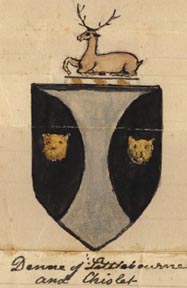 |
Generation Fifteen
Thomas Denne Esq. of Denne
Hill married first to Alice Eshehurst (or Ashurst) and they had three sons:
-
Thomas Denne, of Denne Hill, who married Alicia Mett,
daughter of Thomas Mett
-
William Denne
-
James Denne, of Marley (died at Kingston in 1574)
who married Agnes.
Thomas Denne married second to Margaret Naisshe and they had the following children:
- Christopher Denne
- Michael Denne
- David Denne
- Agnes A'Denne, born in 1520
at Barham Kent and died in 1588; buried on March 29, 1588 at Adisham
Kent. Agnes married Richard Austin; their great X11 granddaughter is:
Generation Sixteen
William Denne Esq. of Kingston,
Kent, proprietor of extensive estates there.
Died on October 21, 1572.
William married Agnes Tufton (died in 1588),
daughter of Nicholas Tufton, Esq. of Northiam Place, Sussex who was the
great grandfather to the first Earl of Thanet.
William Denne and Agnes Tufton had the following children:
-
Vincent Denne of Kingston, LL.D. (died in 1591)
who married Joan Kettell of London
-
Thomas Denne of Adisham, a bencher of Lincoln's Inn
in 1590, who married Jane Swift and from whom is descended the families
of Don PerryandNancy
Thompson. Please click on the names to visit their sites.
-
Mary Denne who married first to John Coppin of Deal
(or Deale), and second Thomas Boys of Eythorne in Kent.
-
Catherine Denne
|
Thomas Denne of Adisham
The Arms of Denne pictured here
were granted to Thomas Denne of Adisham in 1589 and are taken from the
unpublished manuscript by Frederick Slater.
Sir Bernard Burke describes
these arms: "Denne (Denne Hill, Kingston, Elbridge, Bishopsbourne,
and Lydd, co. Kent, and Winchilsea, co. Sussex). Azure three bars ermine
in chief as many fleur-de-lis or." (Sir Bernard Burke: The
General Armory, London 1884, page 278)
Slater describes the crest as
being. "on a chapeau vert, turned up ermine a demi Peacock, wings expanded
and elevated pp."
"This crest was also granted
in 1589 but has not been used from time immemorial."
. . . . .Frederick Slater
|
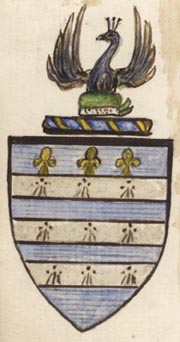 |
|
Denne of Lydd
The Arms of Denne of Lydd pictured here taken
from Frederick Slater's manuscript (1880) and are described by him as follows:
"Quarterly 1st and 4th Three bars ermine in chief, as
many fleur de lis, or. Coat granted to Thomas Denne Esq 1580. 2nd
and 3rd Azure three leopards heads, couped, or."
The Denne of Lydd branch
is descended from
Thomas Denne of Addisham.
|
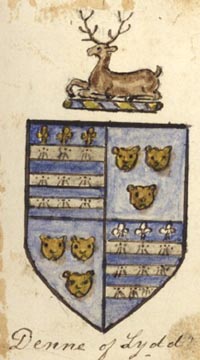 |
Generation Seventeen
Catherine Denne
Married: John Gookin, Lord of the Manor
of Ripple Court, Kent. John Gookin was the son of Thomas Goolkyn
(or Goolken) of Bekesbourne, Kent (died in 1599) and grandson of Arnold
Gookin (or Gokin), probably of Canterbury, Kent who was born as early as
the reign of King Henry VII (1485 - 1509).
Catherine Denne and John Gookin had the following children:
-
Thomas Gookin, Lord of the Manor of Ripple Court who
married Jane Thurston. They had seven children, among whom was:
-
Catherine Gookin who married William Warren, a descendant of David,
Earl of Huntington (1144 - 1219) See Gary Boyd Roberts: The Royal
Descents of 600 Immigrants, Baltimore, 2004, pg. 469 for this descent.
-
John Gookin who married Anne Brett.
-
Daniel Gookin who died an infant.
-
Daniel Gookin, 2nd
-
Sir Vincent Gookin who married 1st to Mary Wood and
2nd to Judith Crooke.
-
Ann Gookin.
-
Elizabeth Gookin who died an infant.
-
Elizabeth Gookin, 2nd.
-
Catharine Gookin who married Thomas Milton.
-
Margaret Gookin who married Thomas Marshe.
|
The Arms of Gookin
The Arms of Gookin pictured here
are based on Sir Bernard Burke: The General Armory,
London 1884, page 406 where it is stated: "Gokin, or Gookeine (Ickham,
co. Kent; granted in 1609 by Segar; the family occurs in the Kent Visitation
of 1619 and in that of 1663). Gules a chevron between three cocks or."
This family is almost certainly
the same as our Gookin Family because Sir Vincent Gookin (see above) was
granted arms that differ only in having a chevron ermine. |
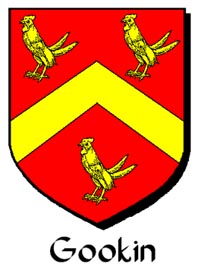 |
Generation Eighteen
Daniel Gookin of Carriagaline,
Ireland. Lived in Kent
Born at Ripple on October 28, 1582.
Died in February or March 1632/3 at the Red Abbey, parish
of St. Finn Barr, Cork City, Ireland.
Daniel Gookin emigrated to Virginia in 1621, but he returned
to England and then to Ireland in the spring of 1622 following a great
Indian massacre on March 22, 1622. There is no evidence to indicate
that he ever returned to the New World. For further details, please
click on the biographical account of his son {Major
General} Daniel Gookin written by Richard N. Gookins of Salem, Oregon
and shared by Norman D. Denzler-Medland.
Daniel married on January 31, 1608/9 in Canterbury Cathedral,
County Kent to Mary Byrd. Mary was a daughter of Richard Byrd, Canon at
Canterbury Cathedral and Elizabeth Meye who was in turn a daughter of John
Meye, Bishop of Carlisle. Mary's birth and death dates are unknown,
but she was buried at Bitton in Gloucestershire on July 27, 1635.
Daniel Gookin and Mary Byrd had the following sons:
-
Richard Gookin, of St. Finn Barr, County Cork, Ireland
was born about 1609 and died before 1655. He was evidently the father
of:
-
John Gookin of St. Dunstan's in the East, London. John was
a mariner. He married Mrs. Francis Pitt of Stepney, Middlesex, a
widow age about 23, on November 21, 1665. John was about 28 at that
time.
-
Edward (or Edwine) Gookin, born at Ripple on June
23, 1611 and died young.
-
{Major General} Daniel Gookin
-
John Gookin who was perhaps a twin of Daniel.
-
Edward Gookin who was born probably in 1615 and died
unmarried before 1655. This could be the same Edward, a "son
of Daniel and Mary Gookin" who was christened on September 24, 1628 at
London, St. Botolph, Bishopgate.
Generation Nineteen
{Major General} Daniel Gookin
who was granted a license to marry his 2nd wife Mary Dolling in 1639 when
he was in London. In 1641 he went with his wife and infant son to
Nanse Plantation, Virginia. On May 20, 1644 he arrived in Boston.
Click on {Major General}
Daniel Gookin for a detailed biographical account of his life written
by Richard N. Gookins of Salem, Oregon and shared by
Norman
D. Denzler-Medland.
In his "Remonstrance of 1680", Daniel Gookin defined
citizens rights which were so fundamental that they were later included
in the Bill of Rights of the United States. Click to see his Remonstrance
of 1680 which was kindly shared by his descendant Eugene Hubbard.
Born: 1612.
| Daniel's date of birth has been determined to be 1612 from his will,
from his epitaph and from his licence to marry Mary Dolling. For details,
see E. E. Salisbury, Family Memorials, Privately Printed,
New Haven, Connecticut, 1885. pages 431 and 432.
His actual place of birth is uncertain. Richard N. Gookins wrote: "His
place of nativity remains a matter of conjecture. When he was less than
four years old, his father was living in Ireland, so it may be assumed
that Daniel's boyhood was spent in Carrigaline . . . ." (Richard N. Gookins,
An
Historical and Genealogical Sketch of The Gookin Family of England, Ireland
and America, Privately Printed, Tacoma, Washington, 1952, page
20)
Later on, Mr. Gookins states: "Daniel Gookin, born presumably in the
county of Kent in 1612 . . .." (Ibid., page 29)
In an unpublished
manuscript, Mr. Gookins states: "The third son of Daniel Gookin of
Carrigaline was born in the latter part of 1612 although the exact date
and place is unknown. He was christened on 6 December 1612 at the
church of St. Augustine the Less, Bristol. If he had been born at
Ripple it would have been logical for the baptism to have taken place there.
In 1616, his father was living in Ireland so it may be assumed that Daniel’s
boyhood was spent in Carrigaline and that he was sent to England for schooling." |
As is often the case with genealogical studies, we find that an answer
gives two more questions . . .
Died: March 19 or 30,
1686/87.
{Judge} Samuel Sewall wrote in his diary for 1686:
| "March 19. Satterday, about 5. or 6. in the morn, Major
Daniel Gookin dies, a right good Man." |
| "Tuesday, March 22, 1686. Major Gookin and Abraham Busby
buried." |
Notes:
(1) Abraham Busby was a linen-weaver.
(2) The calendar had been adjusted by the Pope Gregory XIII in 1582
to address an accumulated error with regard to the length of the year.
Under the new Gregorian calendar which is still in use to-day, the year
began on January 1 and 11 days were "skipped" to eliminate the error.
However, Britain and her colonies continued
to use the old Julian calendar until 1752. Under the Julian calendar, the
year was still 1686 and the new year began on March 25. Hence, for Samuel
Sewall, the date of Daniel Gookin's death was March 19, 1686. We would
now refer to this day as March 30, 1687; and I have stated that Daniel
Gookin died on "March 19 or 30, 1686/87"
. . . Robert Sewell, March 13, 2008
|
{Major General} Daniel Gookin had three marriages:
-
First Marriage: Details unknown. Daniel was referred to as
"a widower" at the time of his second marriage in 1639.
-
Second Marriage in 1639 to Mary Dolling, of the parish
of St. Dunstan in the West, London. Mary was a spinster, aged about
21, whose parents were dead. Mary died in 1683.
-
Third Marriage: to Hannah (Tyng) Savage about 1684.
{Major General} Daniel Gookin and Mary Dolling
had the following children:
-
Samuel Gookin, born probably in England by 1640 and
died in Virginia before 1644
-
Mary Gookin, (1642 - 1702) who married Edmund Batter.
-
Elizabeth Gookin (see Generation Twenty below)
-
Hannah Gookin, born at Roxbury, Massachusetts on May
9, 1647 and died an infant on August 2, 1647.
-
Daniel Gookin, born at Cambridge, Massachusetts on
April 8, 1649 and died an infant on September 3, 1649.
-
{Rev} Daniel Gookin, (1650 - 1717) who married 1st
in 1681 to Elizabeth Quincy (1656 - 1691), a daughter of {Colonel} Edmund
Quincy (1627 - 1697/98) and his first wife Joanna Hoar. {Rev} Daniel's
sister Elizabeth had married in 1680 to {Colonel} Edmund Quincy, thus {Rev}
Daniel's first wife was his sister's step daughter. {Rev} Daniel
married 2nd to Bethia Collicut.
-
{Sheriff} Samuel Gookin, (1652 - 1730) who married
1st to Mary and 2nd to Hannah Sterns.
-
Solomon Gookin, born at Cambridge, Massachusetts on
20 June 20, 1654 and died an infant on July 16, 1654.
-
{Rev} Nathaniel Gookin (see Generation Twenty
below)
Generation Twenty
Elizabeth Gookin was baptized
on March 30, 1645 in Roxbury, County Suffolk, Massachusetts
Born on March 14, 1645 at Boston, County Suffolk, Massachusetts
Died in 1700
Married 1st to {Rev} John Elliot, Jr.
Married 2nd to 1680 {Col} Edmund Quincy (1627
- 1697/98) who had a previous marriage to Joanna Hoar.
Elizabeth Gookin and {Col} Edmund Quincy had a son:
{Reverend} Nathaniel Gookin
of Cambridge, Massachusetts.
Born at Cambridge, Massachusetts on October 22, 1656
Died in 1692, probably at Cambridge.
Nathaniel married in 1685 to Hannah Savage, a daughter
of the widow Hannah (Tyng) Savage who had married about a year earlier
to Nathaniel's father. Thus, Nathaniel married his father's step daughter.
Nathaniel and Hannah had the following children:
-
{Reverend} Nathaniel Gookin II, born on April 15, 1687 at
Cambridge, Massachusetts; and died of a slow fever on August 25, 1734 at
Hampton, Rockingham County, New Hampshire. Nathaniel married on December
21, 1710 to Dorothy Cotton and was settled at Hampton from November 14,
1710 until the time of his death.
-
Habajah Gookin, born on January 23, 1689; and died
on August 1, 1689.
-
Hannah Gookin, born in 1692.
The family of Norman D. Denzler-Medland is descended from Nathaniel
Gookin (1687 - 1734) and Dorothy Cotton. Norm has kindly shared the biographical
material on Major General Daniel Gookin which was written by Richard N.
Gookins of Salem, Oregon.
Norm has also sent along the following background on {Reverend} Nathaniel
Gookin and his wife Hannah Savage:
"Nathaniel (1656-1692) graduated Harvard 1675 and was ordained 15 November,
1682 as successor of Urian Oakes as minister of the First Church, Cambridge.
Married 3 August, 1685, Cambridge, Mass., to Hannah Savage (born 27 August,
1667, died 14 May, 1702).
"Hannah, at the time of the marriage was also the step daughter of Nathaniel's
father Major General Daniel Gookin, who had married Mrs. Hannah Savage,
mother of the above Hannah, about 1684. Hannah's father was Habijah
Savage, (born 1 August, 1638, graduated Harvard College 1659) who married
Hannah Tyng (born 1 May, 1640, died 28 October, 1688). She married
the major general as Widow Savage.
"Hannah Tyng's father was Edward Tyng, Boston merchant (born 1610, died
28 December, 1681) who married about 1636 to Mary Sears.
"Habijah's father was Thomas, son of William Savage (born 1604
died 14 Feb 1682) who came from London 1635 in the ship 'Planter.'
His Mother was Faith Hutchinson, daughter of William H. and Ann Marbury
(birthplace Alford, Lincoln, county england 14 August 1617). Ann
Hutchinson was a preacher and reformer. Driven from Boston, she took
refuge in Providence, Rhode Island, and then went to New York where she
was murdered by Indians. There is a statue of her in Boston." |
Norm has suggested the following links:
Ripple
Farm which is located in the same vicinity as Ripple Court mentioned
in Generation Seventeen.
The
Virginia London Company Records telling of Daniel Gookin's 1621
emigration to Virginia.
Lanacaster,
Massachusetts early records of telling of Indian Raids during
King Philip's War in 1675-1676.
Tombstone
of {Rev} Nathaniel Gookin II (1687 - 1734) at Pine Grove Cemetery,
Hampton, New Hampshire
If the above link to the Tombstone of {Rev} Nathaniel Gookin doesn't
work, please click HERE.
|
For the continuation of this line showing the descendants
of
Elizabeth Gookin and her husband {Judge} Edmund Quincy,
please click on
{Judge}
Edmund Quincy
Please visit the Sewell
Genealogy Site Map for other pages in this series.
click here to return to the top
 This page was set up by Robert Sewell in June 2006 to show the Denne Family
since the earliest known times. Robert Sewell graduated from McMaster
University (Hamilton, Ontario, Canada) in 1967 with a B.Sc. degree in chemistry.
After a year of studies at the University of Toronto's College of Education,
he taught high school science in Collingwood, Ontario for a year and then
taught chemistry, physics and general science in Hamilton, Ontario for
twenty-nine years. Robert Sewell retired from teaching in June 1998.
This page was set up by Robert Sewell in June 2006 to show the Denne Family
since the earliest known times. Robert Sewell graduated from McMaster
University (Hamilton, Ontario, Canada) in 1967 with a B.Sc. degree in chemistry.
After a year of studies at the University of Toronto's College of Education,
he taught high school science in Collingwood, Ontario for a year and then
taught chemistry, physics and general science in Hamilton, Ontario for
twenty-nine years. Robert Sewell retired from teaching in June 1998.







